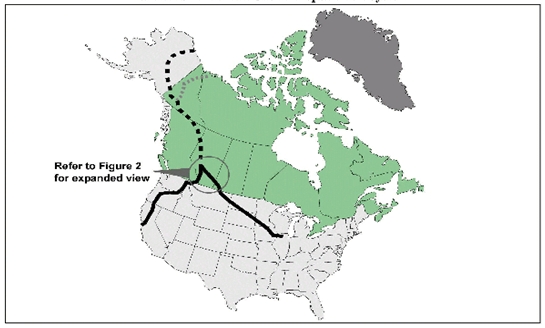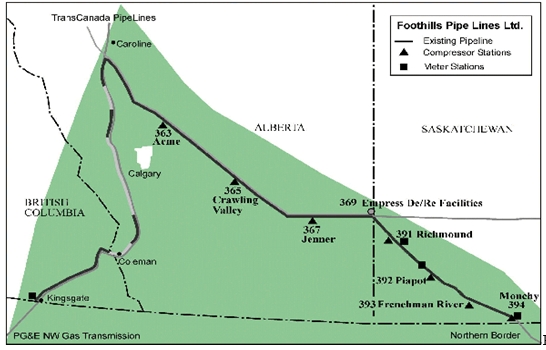Annual Report for Fiscal Year Ended March 31, 2017
Table of Contents
- Overview
- Background Information
- Organizational Structure
- Key 2016-2017 Activities
- Financial Matters
- Organizational Contact Information
Cat No. M175-2017
ISSN 0229-8473 (Print)
ISSN 1927-7261 (Online)
This report is published separately in both official languages.
Copies are available on request from:
Northern Pipeline Agency
588 Booth Street, Room 470
Ottawa, Ontario K1A 0Y7
Email : info@npa-apn.gc.ca
Website : http://www.npa.gc.ca
Telephone : 613-995-1150
Printed in Canada
Overview
The Northern Pipeline Agency (Agency) was established by the Northern Pipeline Act(Act) in 1978 to implement the 1977 Agreement Between Canada and the United States of America on Principles Applicable to a Northern Natural Gas Pipeline. The Agency has a mandate to carry out federal responsibilities in respect to the planning and construction of the Canadian portion of the Alaska Natural Gas Pipeline by Foothills Pipe Lines Ltd. (Foothills). The Agency plays a key role in supporting efficient and expeditious regulatory approval while ensuring environmental protection and social and economic benefits for Canada. Figure 1 shows the proposed route of the entire pipeline system.
The key responsibilities of the Agency are to:
- facilitate the efficient and expeditious planning and construction of the Canadian portion of the Alaska Highway Gas Pipeline (AHGP) project, taking into account local and regional interests, the interests of the residents, particularly of Indigenous peoples, and recognizing the responsibilities of the Government of Canada and other governments, as appropriate;
- facilitate, in relation to the pipeline, consultation and coordination with the governments of the provinces, the Yukon Territory, and the Northwest Territories;
- maximize the social and economic benefits from the construction and operation of the pipeline while at the same time minimizing any adverse effect on the social and environmental conditions of the areas most directly affected by the pipeline; and
- advance national economic and energy interests and maximize related industrial benefits.
Currently the priority of the Agency is to effectively administer the Act to fulfill Canada’s ongoing obligations as set out in the Act and maintain the state of federal readiness should Foothills proceed with the construction of the northern portion of the AHGP project.
Background Information
The Agency was responsible for the regulatory oversight of the construction of Phase I (the southern portion) of the AHGP (also known as the Prebuild) in 1981-82 for the initial purpose of transporting gas sourced from Western Canada to the United States (U.S.). These facilities, located in southern British Columbia, Alberta and Saskatchewan, were expanded five times between 1985 and 1998 under the authority of the Act. The current flow capacity of the Prebuild is approximately 94.5 million cubic metres per day (3.3 billion cubic feet per day). Figure 2 shows the details of the existing Prebuild facilities in Canada.
Figure 1:
The Alaska Natural Gas Transportation System

Figure 2:
The Foothills Prebuild

Phase II (the northern portion) of the AHGP would link the Prebuild with U.S. natural gas reserves at Prudhoe Bay in Alaska. Economic conditions since 1982 have led to several delays in the completion of the AHGP and fluctuating activity levels for the Agency.
In 2008, TransCanada PipeLines Limited (TransCanada), which now owns Foothills, was selected by the State of Alaska under the Alaska Gasline Inducement Act to receive up to $500 (USD) million in State assistance to pursue an Alaska gas pipeline. This large-scale project of 2,762 km, would transport 4.5 to 5.9 Bcf/d of natural gas in a buried 48-inch, high-pressure pipeline from Prudhoe Bay, Alaska, to markets in Canada and the lower 48 states. Project costs were estimated at $32-41 billion (2009 USD) by TransCanada. On March 30, 2012, ExxonMobil, ConocoPhillips, BP and TransCanada announced that they were working together on a work plan to assess liquefied natural gas exports from south-central Alaska as an alternative to a natural gas pipeline through Canada. In February 2013, Foothills/TransCanada notified the Agency that no further work is planned on the AHGP for now, and of their intentions to maintain the AHGP assets in Canada.
Prior to commencing construction of the northern portion of the pipeline, Foothills/TransCanada is required to obtain a comprehensive series of specific approvals from the Agency as set out under the Act. These approvals relate to socio-economic and environmental requirements, routing, technical and engineering design and other matters, such as the demonstration of project financing.
The Agency is also responsible for the administration of the Yukon easement agreement which was entered into on November 24, 1983 with Foothills. Pursuant to the decision under the Act, a grant of easement was issued by Order in Council on November 28, 1983. The easement follows the Alaska Highway from the Yukon-Alaska border near Beaver Creek, Yukon, to the Yukon-British Columbia border near Watson Lake, Yukon. The easement agreement allows Foothills/TransCanada to conduct investigative work on easement lands; however, the company requires the approval of the minister responsible for the Agency before it can begin pipeline construction. Unless the term is once again amended, the agreement will expire on September 20, 2022. In addition to the easement, the Agency holds approximately 220 reserves of land along the pipeline route that could be used to support the construction and operation of the pipeline system.
To align with the reduction in the AHGP project activities for the foreseeable future, the Agency has scaled down its operations to a minimal level to fulfill Canada’s ongoing obligations as set out in the Act. During this time of reduced activities, the Agency will also respond to any incoming inquiries from other government agencies, Indigenous groups and the public. The future of the northern portion of the AHGP continues to rest with its proponents and the commercial marketplace.
Organizational Structure
The Agency’s organizational structure is defined by the Act where the Minister responsible for the Agency is the Minister for Natural Resources. On November 4, 2015, the Honourable Jim Carr was appointed as Minister for Natural Resources.
The Act provides for the Agency Deputy Head, called the Commissioner, to be appointed by Governor in Council. During 2016-17, this position was held by the Deputy Minister of Natural Resources Canada Bob Hamilton until July 31, 2016 and then held by Deputy Minister of Natural Resources Canada Christyne Tremblay for the remainder of the fiscal year.
To obtain the necessary staff resources to support the Agency activities, the Agency had entered into inter-agency agreements with the Department of Justice and the National Energy Board. Through a Services Agreement, Natural Resources Canada provides internal services support, such as administrative, financial, and information technology assistance, to the Agency.
Key 2016-2017 Activities
The Agency continued to deliver on the responsibilities of the Government of Canada that are embodied in the Act and the 1977 Canada-U.S. Agreement by working, as needed, with other federal departments, provincial and territorial governments, Aboriginal groups, the U.S. Federal Energy Regulatory Commission, and the project proponent, Foothills/TransCanada.
To align with the reduction in the AHGP project activities, the Agency reduced its staff levels and reduced its overall activity level.
Financial Matters
The Agency requested and received a reference level of $751,835 for 2016-2017 from the Government of Canada. During this period, the total authorities used by the Agency were $254,331. This expenditure reflects the reduced level of Agency activities required to be undertaken as a direct result of the project status and the ramp down of the Agency staff levels.
In 2012, the Act was amended to eliminate the requirement for the Agency to have an annual audit of the accounts and financial transactions by the Auditor General of Canada. For the 2016-17 fiscal year, the Agency carried out a review of its financial transactions. The Northern Pipeline Agency’s unaudited Financial Statements for the year ended March 31st, 2017, may be accessed through the Agency website at http://npa.gc.ca/Financial Statement 2016-17.
Under the Act, the Agency’s operating expenses are fully cost recovered from Foothills/TransCanada. Payments made by Foothills/TransCanada are deposited directly into the Consolidated Revenue Fund of Canada.
Organizational Contact Information
Further background information and details on the Agency’s authority, mandate and programs are available in the NPA’s 2016-17 Departmental Results Report. This report may also be accessed through the Agency’s website.
The Agency’s contact information is as follows:
Office Address:
588 Booth Street, Room 470
Ottawa, Ontario K1A 0Y7
Phone: 613-995-1150
Email: info@npa-apn.gc.ca
Page details
- Date modified: